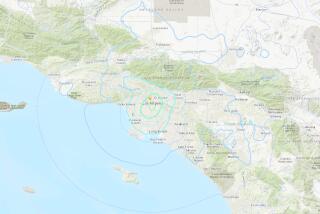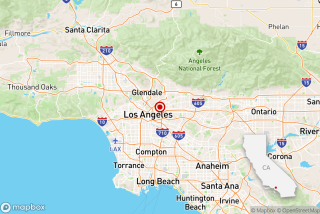Big Quake in Mexico Does Limited Damage
MEXICO CITY — Central and southern Mexico were rocked Thursday by one of the strongest earthquakes to hit the country since 1985, but initial reports said a dozen people were killed and damage was comparatively minor despite the force of the temblor.
The epicenter of Thursday’s magnitude 7.5 quake was near the Pacific Coast resort town of Puerto Escondido in the state of Oaxaca. At least 10 people were killed and hundreds of homes damaged in the impoverished southeastern state.
“Never have we felt anything so powerful,” said Guildebaldo Misangos Calvo, a member of Puerto Escondido’s city council. “There is serious damage to schools, businesses, houses and walls.”
The quake’s destructive power rivaled that of the recent quakes in Turkey and Taiwan, both of which claimed thousands of lives. Seismologists said the Mexican quake caused far less destruction because the epicenter, 275 south of Mexico City, was far from major urban areas. The tremor also was shallow, occurring just seven miles underground.
Still, Thursday’s quake provoked waves of panic in dozens of cities. Two people reportedly died from heart attacks triggered by the agonizingly long tremor, which lasted more than a minute in some areas. The Angel of Independence, Mexico City’s landmark monumental column on the broad Reforma Avenue, swayed like a palm tree.
Thousands of people in the capital poured from downtown buildings into the streets, many in tears. In the Bank of Mexico building, chandeliers gyrated and a fourth-floor marble fountain slurped water onto the floor in the path of evacuating employees and visitors.
The Los Angeles Philharmonic, which performed at Mexico City’s Palacio de Bellas Artes on Tuesday and Wednesday nights, took the tremor in stride.
“Emily Laskin, our director of development, called me midmorning to say that, despite a lot of swaying, everything was fine,” said Rachelle Roe, associate director of publicity and promotion for the Philharmonic. “I told them that if any visiting orchestra is equipped to deal with an earthquake, it’s ours.”
In the elegant colonial city of Puebla, which was badly hit by a magnitude 6.7 quake June 15 that killed 17 people, some churches suffered fresh damage--even as the effects of the earlier quake are still being repaired.
But structural damage appeared largely confined to Oaxaca, where Gov. Jose Murat said that “between 250 and 300 houses are fractured. . . . All the telephone lines and communication systems are cut.”
Misangos, the Puerto Escondido mayor, said dozens of houses were damaged in his town and dozens of people suffered injuries, mostly minor. He said the main coastal highway to Acapulco, about 190 miles northwest of Puerto Escondido, was cut off by landslides, aggravated by recent heavy rains.
“I was 50 meters from the beach, helping organize a fishing contest,” Misangos said. “We didn’t know where to run to. There’s no doubt that we all feel badly affected.
“We have never been through something so powerful,” he said, “even living in an earthquake area.”
Alberto Rodriguez, mayor of the colonial city of Oaxaca, the state capital, told a television interviewer, “There is chaos in the city, much desperation, many people are hysterical and some have fainted.”
The Pacific Coast states of Oaxaca, Guerrero and Michoacan have long borne the brunt of earthquakes in Mexico, although the havoc is often felt far inland.
The terrible earthquake of Sept. 19, 1985, was centered in Michoacan but sent shock waves inland toward Mexico City, much of which was built on soft dry lake beds. The official death toll in the 1985 quake was 4,287--though many believe fatalities were at least double that number--and about 400 buildings collapsed.
But Thursday, there was virtually no damage in Mexico City.
“Fortunately, the epicenter was quite far from Mexico City, and the effects were relatively moderate,” said Roberto Meli Piralla, director of the National Center for Disaster Prevention.
Mexico has suffered 75 quakes that were magnitude 7.0 or greater during this century. Since 1985, only a magnitude 7.6 temblor four years ago was stronger than Thursday’s quake.
Meli cautioned against interpreting the relatively minor damage this time as a signal that Mexico has achieved sufficient earthquake preparedness.
“We are better prepared than we were in 1985,” he said, “but our major cities still have to pass the test of a great-magnitude quake centered close to the major urban areas.”
According to figures from the U.S. Geological Survey in Golden, Colo., Thursday’s quake was the 12th in the world this year of magnitude 7.0 or above.
Carlos Gutierrez, a seismologist with Meli’s center, called the Oaxaca quake “quite ordinary in terms of the seismic history of Mexico.”
He said the temblor was unrelated to the recent quakes in Turkey and Taiwan.
“They are all different scenarios,” he said.
“This is Mexico’s own seismicity at work.”
*
Jose Diaz Briseno in The Times’ Mexico City Bureau and Times staff writer Elaine Dutka in Los Angeles contributed to this report.
SOUTHLAND REACTION
When disaster struck in Mexico and Japan, the reverberations were felt here in L.A. B3
More to Read
Sign up for Essential California
The most important California stories and recommendations in your inbox every morning.
You may occasionally receive promotional content from the Los Angeles Times.










